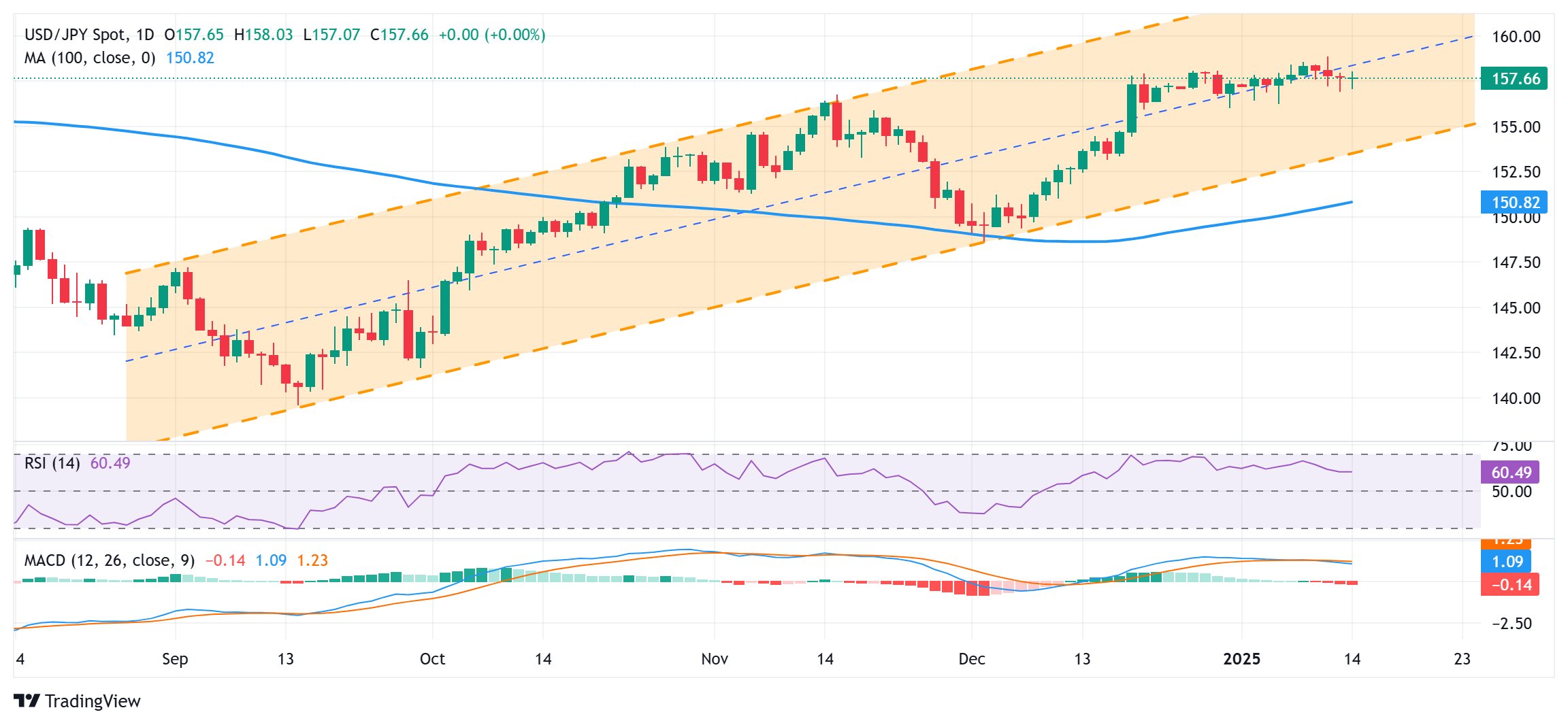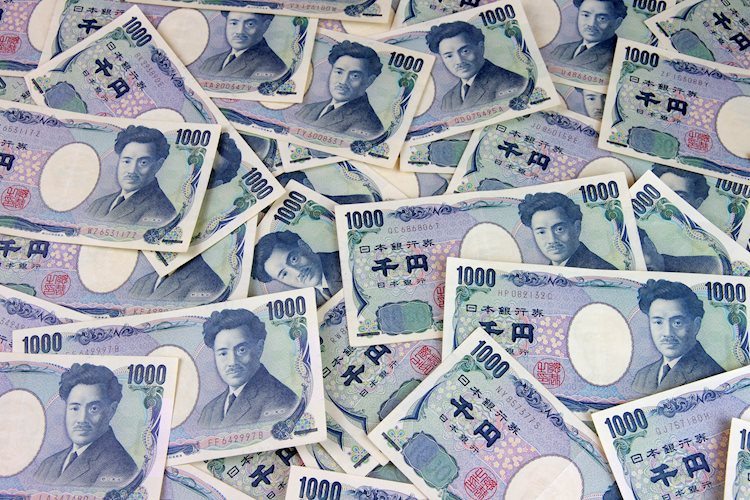Japanese Yen remains on the back foot against USD; looks to US PPI for fresh impetus
- The Japanese Yen attracts fresh sellers on Tuesday amid wavering BoJ rate hike expectations.
- Easing fears about Trump's tariff plans boosts the risk sentiment and undermines the JPY.
- Hawkish Fed-inspired elevated US bond yields favor the USD bulls and support USD/JPY.
The Japanese Yen (JPY) sticks to its neutral bias against its American counterpart, with the USD/JPY pair holding steady just above mid-157.00s through the early European session on Tuesday. Comments from the Bank of Japan (BoJ) Deputy Governor Ryozo Himino further fueled uncertainty about the likely timing of when the central bank will hike rates again. Furthermore, the recent widening of the US-Japan rate differential, bolstered by the Federal Reserve's (Fed) hawkish shift, turns out to be another factor undermining the lower-yielding JPY.
Meanwhile, reports that US President-elect Donald Trump's top economic advisers are mulling a slow ramp-up in tariffs boost investors' sentiment and dent demand for traditional safe-haven assets, including the JPY. That said, retreating US Treasury bond yields, led by easing fears about Trump's disruptive trade tariffs, help limit losses for the JPY and fails to assist the USD/JPY pair to capitalize on its intraday move up beyond the 158.00 mark. Traders now look to the release of the US Producer Price Index (PPI) for short-term opportunities.
Japanese Yen remains confined in a range amid mixed fundamental cues
- Bank of Japan Deputy Governor Ryozo Himino said on Tuesday that while the direction is for further rate hikes, the central bank must carefully watch various upside and downside risks at home and abroad.
- Moreover, some investors are betting that the BoJ may wait until April to seek confirmation that strong wage momentum will carry over into the spring negotiations before raising interest rates again.
- Japan's Economy Minister Ryosei Akazawa said that the BoJ's consideration of a rate hike and the government's aim to exit deflation are not contradictory, and that the BoJ and the government are cooperating well.
- The broadening inflationary pressure in Japan keeps the door open for another BoJ rate hike in January or March. The markets are pricing in over a 50% chance of a rate hike at the upcoming meeting next week.
- According to a Bloomberg report on Monday, US President-elect Donald Trump’s incoming economic team is considering a program of gradual increases in import tariffs over the coming months.
- The proposal aimed at preventing a sudden increase in inflation triggers a modest pullback in the US Treasury bond yields and prompts some US Dollar profit-taking from over a two-year peak.
- Against the backdrop of the Federal Reserve's hawkish outlook, Friday's upbeat US Nonfarm Payrolls report raised doubts about the likelihood of rate cuts in 2025 and should support the USD.
- The yield on the benchmark 10-year US government bond retreats from a 14-month high as investors look forward to key inflation prints, starting with the Producer Price Index later today.
USD/JPY dips towards 156.25-156.20 could be seen as buying opportunity

From a technical perspective, the overnight resilience below the 157.00 mark and the subsequent move up, along with positive oscillators on the daily chart, favor bullish traders. That said, intraday failure near the 158.00 round figure marks it prudent to wait for a sustained strength beyond the said handle before positioning for additional gains. The USD/JPY pair might then accelerate the momentum towards the 158.55 intermediate hurdle en route to the multi-month top, around the 158.85-158.90 zone. Some follow-through buying above the 159.00 mark will set the stage for further gains towards the next relevant hurdle near the mid-159.00s before spot prices aim to reclaim the 160.00 psychological mark.
On the flip side, the 157.00-156.90 area might continue to protect the immediate downside. Any further slide could be seen as a buying opportunity around the 156.25-156.20 area, or last week's swing low. This should help limit the downside for the USD/JPY pair near the 156.00 mark, which if broken decisively might shift the near-term bias in favor of bearish traders and pave the way for some meaningful corrective decline.
Japanese Yen PRICE Today
The table below shows the percentage change of Japanese Yen (JPY) against listed major currencies today. Japanese Yen was the strongest against the US Dollar.
| USD | EUR | GBP | JPY | CAD | AUD | NZD | CHF | |
|---|---|---|---|---|---|---|---|---|
| USD | -0.30% | -0.26% | -0.03% | -0.13% | -0.45% | -0.81% | -0.25% | |
| EUR | 0.30% | 0.04% | 0.27% | 0.18% | -0.15% | -0.51% | 0.05% | |
| GBP | 0.26% | -0.04% | 0.23% | 0.14% | -0.17% | -0.55% | 0.01% | |
| JPY | 0.03% | -0.27% | -0.23% | -0.10% | -0.42% | -0.79% | -0.22% | |
| CAD | 0.13% | -0.18% | -0.14% | 0.10% | -0.33% | -0.68% | -0.12% | |
| AUD | 0.45% | 0.15% | 0.17% | 0.42% | 0.33% | -0.35% | 0.20% | |
| NZD | 0.81% | 0.51% | 0.55% | 0.79% | 0.68% | 0.35% | 0.56% | |
| CHF | 0.25% | -0.05% | -0.01% | 0.22% | 0.12% | -0.20% | -0.56% |
The heat map shows percentage changes of major currencies against each other. The base currency is picked from the left column, while the quote currency is picked from the top row. For example, if you pick the Japanese Yen from the left column and move along the horizontal line to the US Dollar, the percentage change displayed in the box will represent JPY (base)/USD (quote).
Forex News
Keep up with the financial markets, know what's happening and what is affecting the markets with our latest market updates. Analyze market movers, trends and build your trading strategies accordingly.
